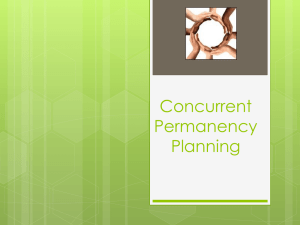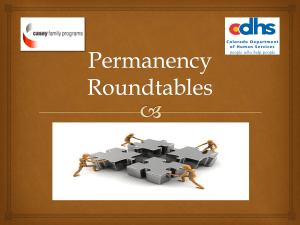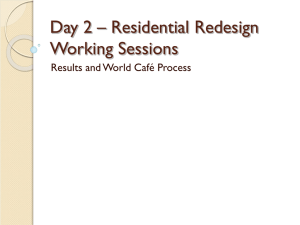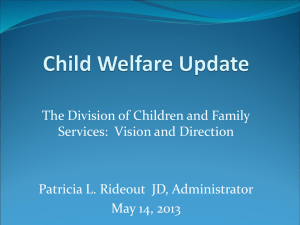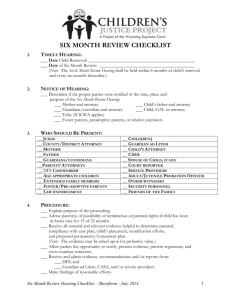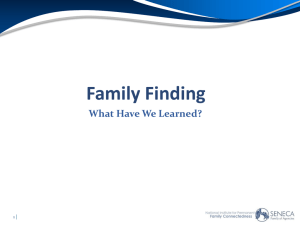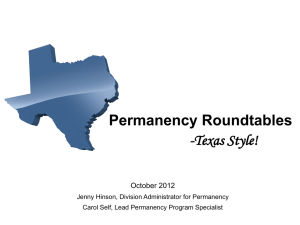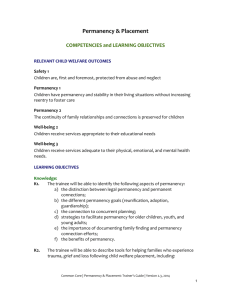4.3 Permanency Planning From Day One Curriculum
advertisement
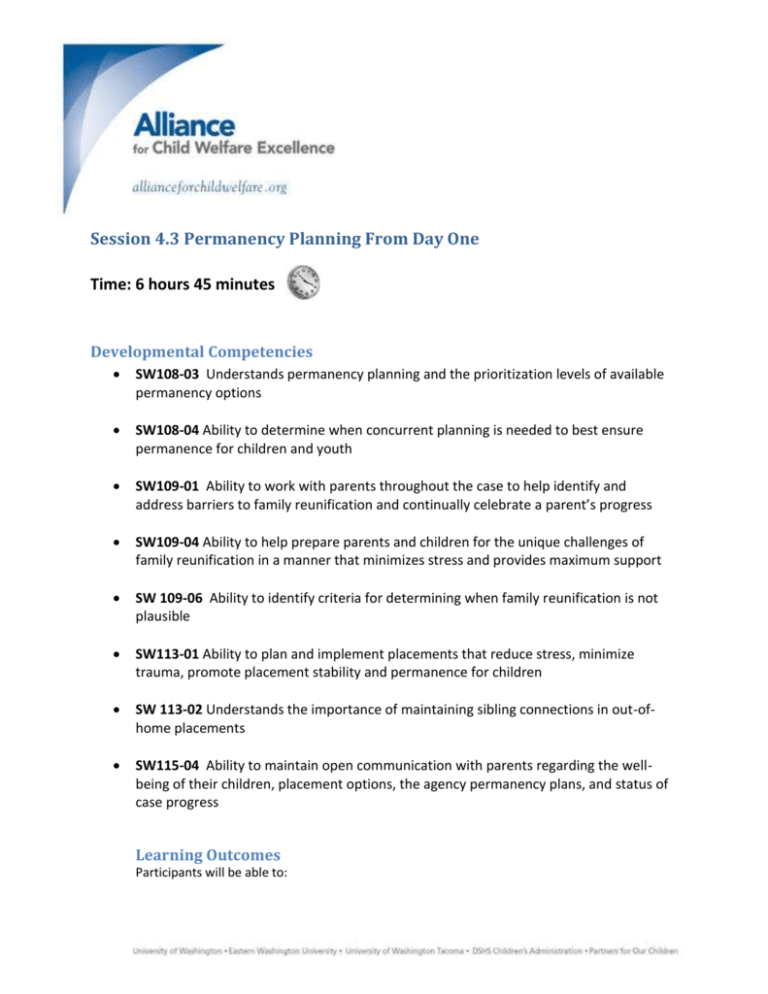
Session 4.3 Permanency Planning From Day One Time: 6 hours 45 minutes Developmental Competencies SW108-03 Understands permanency planning and the prioritization levels of available permanency options SW108-04 Ability to determine when concurrent planning is needed to best ensure permanence for children and youth SW109-01 Ability to work with parents throughout the case to help identify and address barriers to family reunification and continually celebrate a parent’s progress SW109-04 Ability to help prepare parents and children for the unique challenges of family reunification in a manner that minimizes stress and provides maximum support SW 109-06 Ability to identify criteria for determining when family reunification is not plausible SW113-01 Ability to plan and implement placements that reduce stress, minimize trauma, promote placement stability and permanence for children SW 113-02 Understands the importance of maintaining sibling connections in out-ofhome placements SW115-04 Ability to maintain open communication with parents regarding the wellbeing of their children, placement options, the agency permanency plans, and status of case progress Learning Outcomes Participants will be able to: RCT Session 4.3: Permanency Planning From Day One Describe process of reasonable efforts and aggravated circumstances Explain difference between reasonable efforts and active efforts Define permanency and explain its importance in our work Define concurrent planning List the types of permanent plans in their priority order and explain why that order meets the needs of children List timeframes for permanency planning, court hearings, and shared planning meetings Describe case practices to create timely permanency Talking about Competencies In addition to safety and well-being, Children’s Administration is tasked with permanency planning for children in their care. Page 2 of 32 RCT Session 4.3: Permanency Planning From Day One Materials and Preparation Show View/Projector Flip Chart Markers 4.3 Permanency Planning PowerPoint Handouts Handout Exceptions to Reasonable Efforts (called RCW 13.34.234 (4) Aggravated Circumstances) Permanency Planning Benefits and Limitations Mr. Lopez and Kristina Case Scenario Page 3 of 32 RCT Session 4.3: Permanency Planning From Day One Session Flow Step Delivery Method Time 1 PL 4.3 Permanency Planning Worksheet Canvas 15 Minutes 2 3 4 Classroom 4.3 4.3 Worksheet Classroom Canvas 6 Hours 30 minutes Page 4 of 32 RCT Session 4.3: Permanency Planning From Day One Mandatory Information for Coaches Slide 2-3 Trainer’s Notes: These are introductory slides. Just read the slides and pause for dramatic effect Slide 4-5 Learning outcomes READ SLIDES Page 5 of 32 RCT Session 4.3: Permanency Planning From Day One Slide 6 What do you think this number represents? As of September 2012, 9,326 children were in out-of-home placements in Washington State Slide 7 Reasonable Efforts THIS IS A Federal and State law requirement The Adoption and Safe Families Act requires that reasonable efforts be made to prevent placement of a child in out-of-home care and reasonable effort be made to achieve timely permanency for a child who is placed in out-of-home care. In almost all situations a social worker must make reasonable efforts towards reunification. Reunification should be considered as soon as the identified safety threats have been addressed. Page 6 of 32 RCT Session 4.3: Permanency Planning From Day One Slide 8 In Other Words Reasonable efforts is a legal term describing the level of services and assistance that should be offered by a social service or child protection agency to a child and family members during the life of a child welfare case Alas, don’t be confused, this phrase is used in two ways. Reasonable efforts are also used to describe the efforts to achieve a permanency plan, which we will go into more detail shortly. The court must make a finding whether the agency provided reasonable efforts to finalize the permanency plan within 12 months of the child’s removal The finding must be detailed and child specific Now, let’s talk about aggravated circumstances Slide 9 Aggravated Circumstances Handout Exceptions to Reasonable Efforts Page 7 of 32 RCT Session 4.3: Permanency Planning From Day One Here we see a list of circumstances that do not require reasonable efforts, per RCW 13.34.132 (4) Slide 10 Active Efforts For our ICW cases, we are required to provide Active Efforts versus Reasonable Efforts The concept of “active efforts” goes along with what we know is best practice. Active efforts are especially required on Native American/ Alaskan Native/ First Nations cases. They imply “going the extra mile” to assure that historically underserved and oppressed people are supported and their family structure maintained. A cornerstone in the application of active efforts is active and early participation and consultation with the child’s tribe in all case planning decisions. Additionally, active efforts is more intensive than "reasonable efforts." \ For example, reasonable efforts might be only a referral for services, but active efforts would be to arrange for the best-fitting services and help families engage in those services Page 8 of 32 RCT Session 4.3: Permanency Planning From Day One Slide 11 Permanency Definition Activity Divide the class into groups of 3. (Or however it works for your class) Have them write down their definition of permanency. Have each group report out their answers Slide 12 Definition of Permanency READ Slide Page 9 of 32 RCT Session 4.3: Permanency Planning From Day One Slide 13 What is Permanency Planning In addition to safety and well-being, Children’s Administration is tasked with permanency planning for children in their care. The goal of permanency planning is to provide a child with a safe, stable environment in which to grow up, while in the care of a nurturing caregiver, who is committed to a lifelong relationship with that child. A sense of urgency exists for every child who is not in a permanent home. Permanency Planning: • Starts at first contact; • Continues throughout the lifetime of the child’s case until permanency is achieved; • Secures a safe, stable, and permanent home for the child as soon as possible; • Protects the child developmentally; • Protects primary attachments, or • Creates new attachments; and • Preserves cultural and family connections. Page 10 of 32 RCT Session 4.3: Permanency Planning From Day One Slide 14 Basic Permanency Assumptions READ THROUGH SLIDE AND ADD THESE POINTS AFTER: All children, youth and adults, regardless of age, race, culture, ethnicity, sexual orientation, or gender identity, deserve permanency. Permanency provides love, meaning, purpose and continuity in our lives, and supports our continuous development, from childhood through adulthood. Planning for and supporting a child’s permanency begins with the first child welfare contact. It includes strengthening and supporting families to care for children and youth in their own homes. Permanency planning efforts intensify at the point at which children and youth enter the foster care system. Page 11 of 32 RCT Session 4.3: Permanency Planning From Day One Slide 15 Permanency Planning Begins at first contact & is both federally and state mandated. Ultimately purpose is to protect the health and wellbeing of the child Preserves family connections Protects primary attachments or creates new attachments Slide 16 Permanency options/Legal Plans Handout: Permanency Planning Benefits and Limitations The social worker must identify one of these permanency planning options as a primary goal. It is encouraged that permanency planning for children occur in the context of the Shared Planning Meeting process. Our policy states that A permanency planning goal must be identified for all children in out-of-home care no later than 60 days from the Original Placement Date (OPD) per Page 12 of 32 RCT Session 4.3: Permanency Planning From Day One 4301 Shared Planning by following the Shared planning process in the 4301 Shared Planning policy CA's written report to the court must identify a permanent plan to the court that includes how the department is working towards securing a safe, stable and permanent home for the child. These options are Permanent Legal Arrangements and include, in order of legal preference, and when in the best interest of the child: o Return Home o Adoption o Third Party Custody o Guardianship We will now cover each option Slide 17 Return Home Always consider Return Home as the primary permanent plan for a child when all the following conditions are met: o Aggravated circumstances do not exist. o It is likely the child will return home per Reasonable Efforts to Return a Child Home policy. o The plan is in the best interests of the child. o The child (as age and developmentally appropriate) has been consulted regarding the potential benefits and risks of the return home. o Safety threats are eliminated or can be managed or controlled in the family home. Once a child is assessed as safe, they should return home (Conditions for Return Home Review). Page 13 of 32 RCT Session 4.3: Permanency Planning From Day One Slide 18 Conditions for Return Home: Review Trainer’s Notes: This information is repetitive. This was covered in session 3.1. However, this is a quick review in order to connect it to permanency. Also, they need this review to complete the case scenario activity. Always, once a child is assessed as safe, they should return home. If the child is unsafe and out-of-the-home, there are three conditions for return home of an unsafe child. We covered these in session 3.1, but let’s quickly review: Existing threats can be controlled and managed with an in-home safety plan Safety threats no longer exist, parents have increased protective capacities, or The threats can now be managed in the home Parent’s recognize, acknowledge, and understand the threats Parents must demonstrate some recognition, acknowledgment, and understanding of the identified threats and dangers. o While full recognition and acknowledgement is not necessary, there should be some progress toward a clearer understanding of the dangers. o If the parent has made no progress in their understanding of what made their child unsafe, they will not know what is needed for protection and safety. Parents may be able to discuss the threats, they may have improved insight and awareness of how threats endangered their children. An in-home safety plan can be sustained Page 14 of 32 RCT Session 4.3: Permanency Planning From Day One Is the home stabilized? o Is the environment predictable, o Is there a routine? o Who is in the parent’s life? o Are natural supports in place, have relationships been renewed? o Are resources available, accessible and will the parents accept them? o Can the parents accept help now if they were not able to when the original plan was written? Slide 19 Reunification Prevalence As we just learned, return home is our first priority and is planned for in most cases. Data shows us that reunification is most achieved permanency goal Per Children’s Bureau Child Welfare Report to Congress, 2008-2011, 68 % of children that entered foster care were reunified within 12 months. So how about WA, how are we doing? The 2009 Quality Assurance report, the most recent report including this measure, indicates that in that year 71.7% of children who spent at least one night in care were returned to a parent by 12 months. It’s interesting to note that the percentage of children reunified by one year, and the percentage of kids reunifying in general, is actually decreasing. Page 15 of 32 RCT Session 4.3: Permanency Planning From Day One Slide 20 Reunification Case Scenario Reunification Case Scenario Have class read the scenario, and in groups answer the following questions: 1. What would a reunification plan look like? 2. What might the conditions for return home be? 3. What supports could/should be in place for the plan to be successful? Slide 21 Adoption as a Permanency Goal When, for reasons of safety or other considerations, children cannot return to their birth homes, adoption is the preferred goal to offer opportunities for long-term stability Adoption Guidelines Participants in a shared planning meeting determined that adoption is in the best interest of the child. Page 16 of 32 RCT Session 4.3: Permanency Planning From Day One The Tribe, in applicable cases, supports adoption as the permanency plan. Parent’s parental rights have been terminated, relinquished, or it is likely the parents’ rights will be terminated by the court. Reasonable efforts have been made to reunify the family, but the parent has not made sufficient progress to safely return the child now or in the foreseeable future, or Aggravated circumstances existed and reasonable efforts to reunify with the family were not required or the family refuses services and wants to relinquish the child and CA agrees with this plan. After discussion with the child (as age and developmentally appropriate), of the potential benefits/risks of other permanency plans, the child has a stated preference for adoption. If the child is age 14 or older, the child agrees to sign a consent for the adoption finalization. The child has a sibling in the same placement and consideration of the permanent plan for the sibling is included in the consideration of selecting the preferred plan of adoption. Slide 22 Third Party Custody Can someone inform us what “Third Party Custody” is? Correct, under Washington State family law, a person other than a parent may file an action seeking non-parental custody (third party child custody) This goal is chosen when efforts to reunify or adopt are not achievable Here are the guidelines when selecting this goal: Participants in a shared planning meeting determined that 3rd party custody is in the best interest of the child. The Tribe, in applicable cases, supports 3rd party custody as the permanency plan. Continued contact with the parents is not detrimental to the child or the stability of the placement. Parental rights are not terminated. Page 17 of 32 RCT Session 4.3: Permanency Planning From Day One After discussion with the child (as age and developmentally appropriate) of the potential benefits/risks of other permanency plans, the child has a stated preference for 3rd party custody. Reunification and adoption have been ruled out as permanent plans. The proposed custodian(s) has made a commitment to parent the child until adulthood with the intention of lifelong commitment. The proposed custodian(s) understand their responsibilities to the child. The proposed custodian(s) has the financial means and personal abilities to support the child and any special needs the child may have without on-going CA support. Cultural preferences are documented as a factor in the decision. The child has a sibling in the same placement and consideration of the permanent plan for the sibling is included in the consideration of selecting the preferred plan of third party custody. The child has significant ties to the family of origin and this is not detrimental to the child or the stability of the placement. Slide 23 Guardianship as a Permanency Goal While it is true that dependency guardianships under RCW 13.34.232 still are in our laws, however, as a practical matter Children’s Administration no longer enters into dependency guardianships with children under our supervision. The department will not fund them. If guardianship is being considered as a PP, CA staff are to pursue this under RCW 13.36. The order of guardianship is established under RCW 13.36.050 if the court has made the findings under RCW 13.36.040. The department is still honoring the already established dependency guardianships previously entered under RCW 13.34.232 but has converted some to guardianships under RCW 13.36. Two important things are in play in the RCW 13.36 guardianships; o (1) the dependency is dismissed and CA is no longer involved with the families and Page 18 of 32 RCT Session 4.3: Permanency Planning From Day One o (2) there is possible guardianship subsidy funding for relatives who are established as guardians to children under this law. The Relative Guardianship Assistance Program (R-GAP) is a possible resource to provide financial support to qualified relatives who become guardians to our dependent children. (Practice and Procedures Guide policy #43401) For this to be a viable goal, return home, adoption, and third party custody were not successful or an option. Slide 24 Long Term Care Agreement For children who cannot be reunified, adopted or placed with a guardian, the permanency goal must reflect a permanent placement with a nurturing adult with whom there is a strong attachment and sense of belonging. In this case, reunification, third party custody, and guardianship have been ruled out Guidelines The child has been in this identified home for a minimum of 6 months. The child is 16 years or older and after discussion with the child (as age and developmentally appropriate) of the potential benefits/risks of other permanency plans, the child prefers a long-term care agreement as the plan. The caregiver(s) has made a commitment to care for the child until age 18 (or beyond in EFC) and to transition the child into adulthood, utilizing the available ILS services. The caregiver(s) has shown an ability to meet the child’s special needs and has agreed to sign the long-term care agreement. The caregiver(s) agrees to cooperate with Children's Administration in shared planning for the child regarding services, visits with biological family, Tribes, and other cultural connections. The child has a significant connection to the caregiver(s) and this is a reciprocal connection. Long-term care agreement may be with a licensed foster home or unlicensed relative of specified degree. Page 19 of 32 RCT Session 4.3: Permanency Planning From Day One The child’s special needs warrant on-going case management by Children's Administration and/or contracted provider. The child’s special needs require a high level of financial and agency support, including respite care that cannot be met in an adoption, third party custody, or dependency guardianship. Slide 25 Concurrent Planning Now that we have an understanding of permanency, permanency planning, and our order of permanency planning goals, let’s talk about concurrent planning Ask the large group, what is concurrent planning? Move to the next slide for the definition Slide 26 Concurrent Planning Concurrent Planning is a process of working towards family reunification while, at the same time, developing an alternative permanent plan. Page 20 of 32 RCT Session 4.3: Permanency Planning From Day One Planning occurs concurrently rather than sequentially. In addition to the development of the plan itself, concurrent planning requires that caseworkers work toward reunification of a child with his or her own family while, at the same time, work on the tasks identified in the alternate plan that has been developed to help the child achieve permanency. Slide 27 History of Current Planning In the late 1960s and 1970s, Irmgard Heymann and her colleagues, working in Chicago, first formulated the concept of concurrent planning although they did not label it as such. Their work led them to conclude that earlier permanency could be achieved when a caseworker frankly discussed permanency with parents when their child first entered foster care and assessed parents’ visiting patterns. Following the enactment of the Adoption Assistance and Child Welfare Act of 1980, many states developed permanency planning approaches, although most of these approaches involved sequential planning. The most common practice was that caseworkers first pursued reunification for the child and parents and, if reunification efforts failed, they explored adoption or other permanency options. In the early 1980s, the Washington State Department of Social Services, in collaboration with Linda Katz at Lutheran Social Services, coined the term “concurrent planning.” Their approach recognized that in cases where the prognosis for reunification was poor for young children, it was important to place children, as early as possible, with foster families who could become their permanent families if reunification was not successful. Over the following decades, other communities implemented concurrent planning practices. How about a SHOUT OUT for Washington!!!! Page 21 of 32 RCT Session 4.3: Permanency Planning From Day One The Adoption and Safe Families Act of 1997 impacted the practice of permanency planning and provided an environment in which concurrent planning begin to be viewed differently. This Act provided parameters for pursuing termination of parental rights immediately, in certain circumstances, and defined clear time frames for pursuing termination of parental rights, unless the there were exceptions or compelling reasons. Additionally, the Act specifically authorized the use of concurrent planning as a means of achieving permanency more expeditiously. Slide 28 Goals of Concurrent Planning What are the goals/purposes of concurrent planning Here we see the 4 main goals of concurrent planning’ Ask the large group; is concurrent planning the same as permanency planning? Answer: Concurrent Planning is a specific modality of permanency planning. It is the ongoing process of actively working two permanency plans in cases identified as appropriate for concurrent planning Page 22 of 32 RCT Session 4.3: Permanency Planning From Day One Slide 29 Concurrent planning includes: Here we see how concurrent planning looks in the FamLink Court Report (Click again for arrow to display) We always have reunification (unless for aggravated circumstances) reunification as the Primary goal Our Alternate goals are adoption, third party custody, and guardianship: in that order Slide 30 Concurrent Planning Practices CPS must make attempts to introduce the concept, but focus on the agency’s efforts to ensure timely permanency. It is important that we make sure that parents understand that reunification is first and foremost, AND, that they have a voice in the alternate plan A concurrent plan is only a back up plan. The court, not the agency, determines when permanency goals change. Ask the group for best ways and times during the case to bring up concurrent planning to parents. Utilize experience in the room to develop strategies that have or are likely to be successful with various types of client. Possible answers: Page 23 of 32 RCT Session 4.3: Permanency Planning From Day One Discuss permanency plans with parents and placement caregivers early and often. Use shared planning meetings. Ensure that foster parents/caregivers are involved and informed. Always let parents know exactly when and how services/action steps are to be completed Now ask the group to identify what the benefits of concurrent planning for children, youth, and families are. Document their responses on a flip chart Answers: For children and youth, the benefits are: Fewer placements while in foster care when children/youth are placed with resource families who support reunification and relative placement, yet stand ready to be the child/youth’s permanent family should such efforts not be successful Earlier permanency through reunification or another permanency option Greater opportunities to benefit from all the caring adults in their lives as resource families and birth parents jointly work together to meet the child/youth’s needs For families, the benefits are: A clearly communicated sense of urgency in achieving permanency for their children/youth Prompt access to services as planning begins immediately upon the child’s/youth’s entry into care When reunification is not the outcome, a foundation for ongoing connections with the child/youth through open adoption or openness in guardianship arrangements Page 24 of 32 RCT Session 4.3: Permanency Planning From Day One Slide 31 Now let’s discuss how this plays out in our practice Slide 32 Timeframes for Permanency Permanency planning goals must be identified no later than 60 days from the Original Placement Date (OPD) and preferably no later than 30 days from OPD. A permanency planning hearing must occur if, following 90 days of service delivery after disposition, the parents have failed to make progress or engage in services in resolving the issues that brought the child into care. This may coincide with the initial review hearing which is to be scheduled for in-court review six months from OPD or 90 days from the entry of the dispositional order, whichever comes first. Permanency planning hearings must occur for all children by the 12th month of out of home care. In aggravated circumstances cases, where reasonable efforts are not ordered under RCW 13.34.132, a permanency planning hearing shall be held within thirty days of the court order to file a petition to terminate parental rights. Permanency planning hearings must occur within one year of a previous permanency planning hearing until legal permanency is achieved. Page 25 of 32 RCT Session 4.3: Permanency Planning From Day One Adoptions are to be finalized by the 24 month of out of home placement and within 6 months of termination of parental rights. When parental protective capacities have not increased to eliminate the safety threat the social worker should already have implemented the alternate plan to decrease time in out of home care Permanency planning hearings must occur annually (within one year of a previous permanency planning hearing) until permanency is achieved. Permanent plans must be finalized within: o Reunification (within 12 months) o Timely adoption (within 24 months) If the permanent plan is reunification the child must return home within 3 months of the permanency planning hearing A petition to TPR must be submitted to the Attorney General's office by the end of the child's 12th month in out-of-home care or sooner, when it is in the child's best interest and meets at least one of the following: o The child is in out-of-home care twelve (12) of the last nineteen (19) months. o The child is determined by the court to be an abandoned child. o The child is in out-of-home care for a period of at least six months since dependency finding. o Aggravated circumstances have been found by the court. The TPR petition must be made within 60 days of this court finding. A TPR may be considered earlier in the dependency process when the parents have failed to engage in services and the child has been in care for 90 days since the disposition. A petition for TPR is not required when compelling reasons exist. Relinquishment of parental rights may be accepted when adoption is in the child's best interest per 1701. Shared Planning. The relinquishment of parental rights of an Indian child must occur before a court judge per 6.85 Indian Child Welfare Manual. Page 26 of 32 RCT Session 4.3: Permanency Planning From Day One Slide 33 Compelling Reasons A social worker must have compelling reasons to not file for termination of parental rights when a child has been out of the home for 12 of the past 19 months. Compelling Reasons Have participants get into groups of 2 or 3 (depending on class size – if a small cohort have them work as one group) Have them come up with a list of compelling reasons (what they think might be a reason to not file a TPR) Report out and chart Compelling reasons include, but not limited to: Birth parents are making significant progress and reunification (trial return home) will occur within three (3) months. Birth parent(s) has been accepted and is demonstrating compliance in a dependency treatment court program, long-term substance abuse or dual diagnosis program. The department has not provided to the child's family such services as the court and the department have deemed necessary for the child's safe return home. Adoption is not an appropriate permanent plan due to: o The child is over the age of 14 and after a discussion about adoption and other permanency options with the child, the child opposes adoption as a permanent plan. o The child is placed with a relative and after a discussion about adoption and other permanency options with the relatives; another permanency option with the relative is in the best interest of the child. The court or CA has determined that: Page 27 of 32 RCT Session 4.3: Permanency Planning From Day One o A birth parent is considering relinquishment within a reasonable time to free the child for adoption. o A non-offending parent is pursuing an alternate permanent plan. o A professional assessment of the child determines the child's is unable to remain within a family setting. The parent is incarcerated and: o The incarceration is the only reason for filing the TPR; and o The court has determined the parent maintains a meaningful role in the child's life. The child's Tribe is opposed to adoption and has identified another acceptable permanency plan for the child per RCW Slide 34 Why All This Matters Permanency planning should not be confused with ‘permanent care’ or ‘permanent outof-home placement’. It is intended to place an emphasis on meeting the child’s need for stability, permanency and continuity of relationships The longer a child is in care, the less likely reunification is possible The focus of permanency planning is to prevent children drifting in care from one placement to another or through multiple attempts at reunification. Evidence on early brain development demonstrates the importance of attachment and stability for children’s healthy physical, emotional, and psycho-social development and learning. Children need consistent and available parenting to provide the nurturing environment necessary to engender feelings of safety, belonging and wellbeing. Recent neuroscience research shows that positive nurturing stimulates growth in the brain, while neglectful care can result in withdrawal or disorganisation. Research also shows that insecure attachments and the negative patterns associated with them can be repaired when positive emotional relationships are formed. The timeliness of decision-making regarding a child’s permanency and stability is particularly important for younger children because the first two years of a child’s life Page 28 of 32 RCT Session 4.3: Permanency Planning From Day One are the most critical for the development of emotional attachments, and the first three years of life, for the establishment of competence and coping skills. Slide 35 Can you think of some ways in how we can help provide timely permanency? Slide 36 Case Practices… Completing a comprehensive relative search. o As we know, placement with a relative resource as soon as possible increases stability for children in our care. Providing frequent parent-child-sibling visits. o Visits between parents and sibling increases the likelihood for reunification and maintains family bonds and attachment. Quickly placing a child with a permanency family helps decrease placement moves. Referring child for a comprehensive assessment identifies any special needs and the caregivers ability to meet the needs. Page 29 of 32 RCT Session 4.3: Permanency Planning From Day One Referring permanency family for an AHS, adoption is the alternate permanent plan of choice when it is in the best interest of the child and parental rights are terminated. Slide 37 Steps to Decrease Length of Stay Our priority is to partner with the family and make all necessary efforts to reunify them with their child We can improve this by having a consensus with family on what areas of concern need to address through case plan objectives As we monitor the case , we utilize monthly parent visits to discuss progress (or lack of) towards case plan objectives Also in our contacts with parents, from the very first one, we remain transparent about concurrent planning and the steps/timeframes involved We also must help parents to extend their team or network We do this by casting a wide net to find other family members and other significant people We empower this team and keep them informed throughout the life of the case This is done through shared planning meetings – everyone at the table to partner in decision-making If available in your area, utilize permanency roundtables to help find permanency solutions Page 30 of 32 RCT Session 4.3: Permanency Planning From Day One Slide 38 – 40 Trainer’s Notes: The next 3 slides are the closing slides. These are meant to be read through and pause for discussion from class. Page 31 of 32 RCT Session 4.3: Permanency Planning From Day One Closing Remind students to complete the 4.3 Permanency Planning Worksheet in Canvas Page 32 of 32

